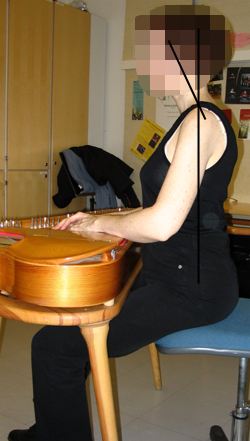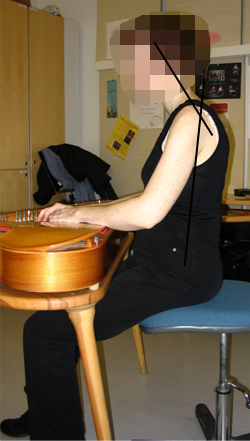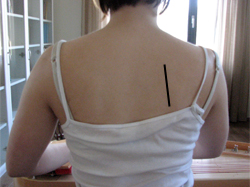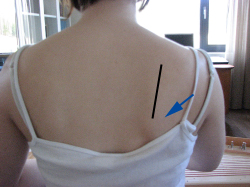Kantele - harjoittelu
Kantele
Read the Ergonomics Overview first.
The body's centre position is the basic position to which the musician always returns. In the centre position, the spine maintains its natural curves. Spinal curves vary between individuals; in the centre position, the backs and hips of different people may look different.
Kantele players should first adjust the seat/table to a height where he or she can easily maintain the pelvic centre position and sit on top of the ischia. The posture should tilt forward slightly so that the midriff ! support muscles are engaged and support the seating position - which is very static for kantele players. The head also maintains a more natural position when the spine tilts forward. The table and the kantele should be set at a height where the elbows are bent approx. 100-110 degrees. This instrument height provides the ideal wrist extension angle of 15 degrees. The shoulder blades are also well supported when the 100-110 degree angle is maintained at the elbow joint. If the musician sits higher or the instrument table is too low, the arms extend and work in a lower position. This affects the muscular support of the shoulder blade, and the wrist angle deteriorates.
|
The pelvis and the lumbar spine are in the centre position, as are the head and neck. The musician looks down by using the axis in front of the ear. |
The pelvis tilts back, the lumbar spine is overextended, the head and neck push forward, increasing the strain on the neck area. The musician looks down by using the axis at the back of the neck. |
Good muscular support of the shoulder blade enables the musician to relax his or her arms. For kantele players, a typical faulty position involves tilting the shoulder blade forward, causing it to come away from the spine, drop and sometimes wing off of the ribs. The problem is more common for the right hand because it works further away from the torso, increasing the load on the shoulder blade muscles.
|
Shoulder blades are correctly supported against the rib cage. |
The shoulder blades are poorly supported against the rib cage; in particular, the right-hand shoulder blade tilts forward and wings off of the rib cage; the bottom corner of the shoulder blade rotates towards the spine. |
The faulty position of the shoulder blades increases the muscular load in the upper arm, forearm and the neck and shoulder region. When the shoulder blade is supported correctly, the hand feels light and relaxed.
For the best finger movement, the ideal wrist angle is 15 degrees extended and 15 degrees tilted towards the little finger. The position facilitates muscular action in the palm, which helps to maintain the traverse arches of the hand. When the hands are in a natural position, the musician has a good grasp on the sensitive strings of the kantele. If the hands are not supported sufficiently, the finger joints move too far and fail to maintain the hand posture, affecting the touch and the sound.
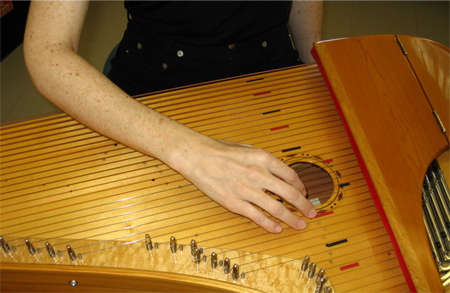
The wrist is in the centre position, the knuckles form a uniform arch, and the fingers maintain their curve. This position provides optimal finger control and string contact.
It is also important to maintain the thumb in a curved position. The middle thumb joint is supported by the muscles located at the base of the thumb (close to the wrist). When the hand and the fingers are arched during playing, it means that the hands have good muscular support and that the finger muscles that extend over the wrist are not overexerted.

